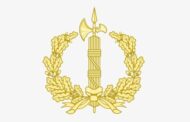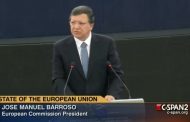In July of 1994 the G7 Summit was held in Naples. They agreed to have a ministerial meeting in Brussels to give ministers an opportunity to discuss ways to “encourage and promote the innovation and development of new technologies, including, in particular, the implementation of open, competitive, and world-wide information infrastructures” (Note: 1998 it became G8 when Russia joined)
G7, 1994 Summit in Naples, Italy (Jobs & Growth #4)
G7, 1995, European Commission documentation on the Brussels meeting of G7 Ministers.
The following is a brief summary of the agreed upon first applications for the Global Information Society as defined by the Bangemann Group.
“The aim is to use existing research results and technologies available to bring applications into real life. The Bangemann report proposed ten priority application areas teleworking, distance learning, a network of universities and research centres, telematic services for SMEs, road traffic management, air traffic control, healthcare networks, trans-European public administration network, electronic tendering and city information highways.”
Following the recommendations of the Bangemann Group, eleven pilot projects were approved and the country coordinators were assigned. Below is the list of the pilot projects. Note: the webpage with the pilot project was different than the interim report as it pertains to country assignments. The assignments given below are from the interim report.
Ron Brown, Secretary of Commerce representing the U.S.
Theme 1: Global Inventory Project
Operational Co-ordinators: European Commission, Japan
The coordinating bodies were to maintain a single repository for information including studies and progress reports about the global information society projects.
“It aimed to create and provide an electronically accessible multimedia inventory of information regarding major national and international projects and studies relevant to the promotion and the development of the global information society. An assessment of social, economic and cultural factors impacting on its development was also undertaken.”
Link to G7 Global Inventory Project Description
NIST Server for US-G7 Global Projects
Theme 2: Global Interoperability for Broadband Speed Networks (GIBN)
Operational Co-ordinators: Canada, Japan,
The purpose was to facilitate the establishment of international links between the various high networks and testbeds supporting advanced applications.
At the time this webpage was published, there were 19 major applications projects developed for the purpose of stimulating the interconnection of high speed, national and regional broadband research networks.
U.S.A.
High Performance Applications Requesting High-Speed Broadband
Theme 3: Cross-cultural Education and Training
Operational Co-ordinators: France, Germany
The aim of the project was to develop an international network for language education and training including the cultural dimension required to communicate adequately in another language.
Theme 4: Electronic Libraries: Bibliotheca Universalis
Operational Co-ordinators: Japan and France
Bibliotheca universalis – Partners
“The aim is to exploit existing digitization programmes in order to build up a large distributed virtual collection of knowledge and make it available via the global communication networks, enhancing the services to the end users. In this way, it is hoped to advance international cooperation towards the establishment of a global electronic library system.”
A network architecture based on distributed digital servers and a common interface for retrieval and navigation tools will be implemented. Existing standards in the field of text, image and sound digitization and of communication protocols will be employed.
[Note: This is interesting. UNESCO is listed as an observer but the link goes to a webpage maintained at McGill University (Arts) for the United Nations Special Coordinator in the Occupied Territories (UNSCO). Is that a mistake? Not likely. At the bottom of the page, there is a link to the Interuniversity Consortium for Arab Studies ]
USA
Theme 5: Electronic Museums and Gallaries
Operational Co-ordinators: Italy and France
The link went to what appears to be a website with museum information but it’s in Italian with no translation feature.
Theme 6: Environment and Natural Resources Management
Operational Co-ordinators: Canada
The link to information on the G7 environment and natural resources management project deserves some time and attention. One might ask, what’s benefit of looking at this old stuff. It’s because when you are talking about systems and the operation of government in conjunction with global collectivism with other nations, the first moments of initiation set the direction for decades and perhaps even permanently. The condition of our country today (decay and decline) is a direct result of designing a global system of governance to coordinate and operate “smoothly” with other countries. That’s not American government. That is a foreign parasite cannibalizing the American government and way of life.
G7 Environment and Natural Resources Management Project – Experts Page
Theme 7: Global Emergency Management Information Network Initiative (GEMINI)
Operational Co-ordinators: USA
GEMINI aimed to set up a global emergency information and management network. 28 demonstration projects from seven countries were established in the following 4 categories: networks, communication, support functions, and specific hazards. Its objective was to encourage the development of a global management information network to enhance the management of emergency response situations, risks and knowledge.
U.S.A.
The link on the project matrix page for the GEMINI system went to a letter from Secretary of Defense (former Senator) William Cohen to Vice President Al Gore. The implications are that the U.S. contribution to global emergency response was to be provided by the military which does make sense within the context because only the military has the capabilities required for such a system.
Letter from Sec Def William Cohen to VP Al Gore
First sentence of Cohen’s letter:
As an enthusiastic participant in the National Partnership for Reinventing Government,
Notice the broken link for the logo at the top left. A search of the archive for the file name nprlogo.gif was done to find a page that had the logo. This page was found:
The obvious conclusion is that Al Gore’s Reinvention of Government was done in conjunction with the G7 plans for the Global Information Society in collaboration with the countries listed as coordinators as well as others that joined into the effort.
Some 25 years later, it’s not clear we have an American government. It is seen most clearly in the Justice Department, the Environmental Protection Agency and in our systems of Education.
Theme 8: Global Health Care Applications
Operational Co-ordinators: European Commission
The European Commission website describes applications for retail medicine as well as a mention EU Research, biomaterials development, and medical education and modeling tools.
Global Health Sub-projects with country coordinators listed * * * LOOK AT THIS * * *
Note: The links in this section were obtained from the NIST Server Applications for the U.S. above in Theme 1, Inventory of Global Information Systems. More detail about this G7 Global System will be covered in a separate article.
Theme 9: Government On-Line
Operational Co-ordinators: European Commission, UK
Government Online
Participating Countries and Organizations
The Government On-Line project is being jointly led by Canada (Treasury Board Secretariat) and the UK (CCTA). Secretariat support is provided by CCTA, UK.
Smart Cards *** Is this how our vital statistics records ended up at a private company in the UK?
Theme 10: Global Market Place for SME’s
Operational Co-ordinators: European Commission, Japan, USA
SME = Small and Medium Enterprises
A Global Market Place for SMEs (Is this why all the adult children and relatives of politicians went into business and got government contracts all over the world? I think so. It’s called self-dealing. Is this why there has been so much fraud with small businesses – marketing image because there is no substance? Wasn’t this the perfect setup for the drug business – using small businesses producing “vapor ware” while laundering dirty money?)
Regional contact points and coordinators note: U.S. NIST and University of Massachusetts – Boston
Final Report (note: converted from Word ’97 to a pdf).
Theme 11: Maritime Information Systems
Operational Co-ordinators: European Commission, Canada
MARIS – Maritime Information Society
MARIS Projects Note especially Intermodal Logistics and Port Telematics
Joint development of U.S. government systems with foreign governments by definition brought defense (military) into the global cyber sphere.

In the United States, the highways in the U.S. were built as defense highways so that the military could move quickly across the country if necessary to defend the country. The domestic highways overlays the defense highways. The military highways use the name STRAHNET and STRAHNET Connectors but they are highways and connectors that serve domestic transportation needs as well.

The transportation system and the global emergency management function of the military necessarily required integration at the state and local levels of all first responders, the emergency 911 systems, emergency rooms, etc. into a military command structure behind a civilian front. The organizations involved principally include the National Guard, Coast Guard, Public Health and SME Contractors to defense oriented corporations.
Reports:
Living and Working in the Information Society: People First
EU Research helps human body “repair itself” after an accident (note: “bio-hybrid organs”)
G8 Global Information Systems, Pilot Projects, Final Report, Dr. Werner Müller
Information Assurance – Legal, Regulatory, Policy and Organizational Considerations
Articles:
Just What the Doctor Ordered? “Innovation and Technology”, Health Care Research (includes reference to genomics), September 1999
Technology Transfer – Building a European Information Society
External Websites:












2 Comments
Kristin
Vicky do you recall a pdf I think I sent you yrs ago, it was titled something like “our employment future in ten years, if everything goes right” it contained an image of a pyramid- focusing on the change of jobs in US. All “work” was to go overseas/3rd world, and all R&D was to stay here (or start here) in other words, no more industry in this country- they called that progress! I know of an empire that is long extinct based on that very goal, it was the Ottoman Empire. Anyway, what I’m thinking is that this COVID lockdown was to start the impetus, to set the stage for “smart jobs only”. What do you think.
Vicky
There is absolutely no doubt in my mind that the COVID thing is the kick-off for the global reset (economic system of the world). When our economy crashed they figured out (don’t know why it took a crisis to figure it out), that having all the manual labor go overseas leaving all the R&D work here. That was stupid considering that only about 5 % +- of the population can do those high end jobs.
I have this report that has a pyramid of the planned composition of the labor force. See page 8. I don’t know if this is the report you’re thinking about. I do know that you didn’t send it to me so you might be thinking of a different report. If you can give me a little more information, I can search my hard drive. I keep almost everything.
http://www.channelingreality.com/Education/SCANS/ToughChoices_EXECSUM.pdf